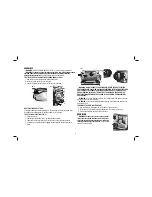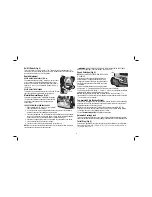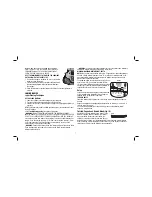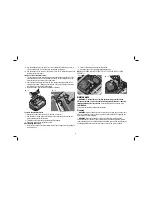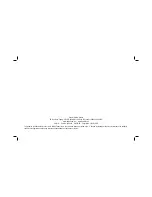
6
On/Off Switch (Fig. 5)
To turn the planer on, lift the switch (L) up. The planer locks on automatically. To
turn the tool off, press the switch down. A hole is provided under the switch (M) for
insertion of a padlock to lock off the planer.
Depth Adjustment
DEPTH ADJUSTMENT SCALE (FIG. 6)
The depth adjustment scale (N), located on the right front
N
FIG.6
of your planer, indicates the finished thickness of your
workpiece. One rotation of the depth adjustment crank is
equal to 1.6 mm (1/16"), half rotation is equal to 0.8 mm
(1/32"), etc.
DEPTH ADJUSTMENT CRANK
Turning the crank clockwise lowers the cutter head. Turning
the crank counterclockwise raises the cutter head.
Material Removal Gauge (Fig.7)
Your planer is equipped with a material removal gauge
O
FIG.7
(O). It is used to indicate the amount of wood that will
be removed in one pass with the carriage set at its
current height.
TO USE THE MATERIAL REMOVAL GAUGE
1. Slide approximately 75 mm (3") of your ma terial
under the middle of the carriage.
2. Be sure the wood is lying flat against the base of the planer. If the material is
inserted at an angle, the reading may be inaccurate.
3. Crank the carriage down on the ma terial until the material removal bar engages
the wood. You will see the red arrow begin to move up the scale indicating the
amount of material to be removed with the carriage at that height.
4. Adjust the carriage height until the desired depth of cut appears on the gauge.
5. Pull the material out from under the carriage.
6. Turn the unit on and feed your material into the cutter head.
NOTE:
Do not exceed the recommended depth of cut for various widths of material
recommended on the material removal gauge.
WARNING
:
DO NOT SWITCH THE UNIT ON WITH THE MATERIAL POSITIONED
UNDER THE CARRIAGE. SERIOUS INJURY COULD RESULT.
Speed Selection (Fig. 8)
NOTE:
ONLY SWITCH SPEEDS WHEN THE PLANER
FIG.8
P
IS RUNNING.
Your planer has the ability to feed materialat two
different speeds. The two-speed feature (P) was
designed to improve efficiency when planing and to
provide the best possible surface finish to a variety
of materials.
To remove material thickness more quickly, set the
unit at speed “2”. This setting delivers 96 cuts per inch to the material.
For finishing, set the unit to speed “1”. Speed “1” is ideal for ensuring the finest finish
on the last pass before your final thickness is achieved.
NOTE:
When planing particularly hard or figured species of wood, speed “1” is
recommended. The slower feed rate will reduce knife wear and tear-out by delivering
179 cuts per inch to the material.
Fan-Assisted Chip Ejection System
Your planer is equipped with a fan-assisted chip ejection system to aid in exhausting
chips from the unit. The fan-assisted chip ejection system will work in conjunction
with independent dust collection systems.
NOTE:
It is not recommended that a shop vac be connected to the DW735. The
capacity of most vacs does not support the volume of chips ejected during planing.
The vacuum hose may clog stopping the flow of chips.
See the
Troubleshooting Guide
, for additional information.
Automatic Carriage Lock
There is no manual carriage lock on your planer. A device that automatically minimizes
the movement that causes snipe during planing is designed into the four threaded posts.
Turret Stop (Fig. 9)
Your planer is equipped with a turret stop (Q) for repetitive planing at pre-set depths.
Stops are set at 3 mm (1/8"), 6.5 mm (1/4"), 12.5 (1/2"), 19 mm (3/4"), 25.5 mm
(1"), and 32 mm (1-1/4").
Summary of Contents for DW735-XE
Page 1: ...DW735 XE 330 MM 13 HEAVY DUTY PORTABLE THICKNESS PLANER INSTRUCTION MANUAL ...
Page 2: ......
Page 15: ......







